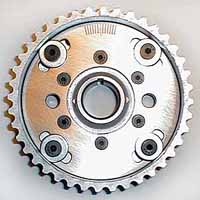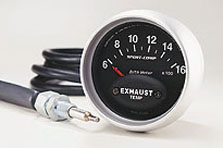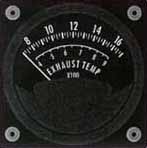
Tuning the Naturally Aspirated
Chrysler
There are three tuning variables that you can control-
1) Cam timing
In general advancing the cam timing increases low end power and throttle response. Retarding the cam timing will cause a loss of low rpm power but will enhance upper rpm breathing. The best way to tune your cam timing and find your engines "sweet spot" is on a chassis dyno. Cam timing cam be altered with an adjustable cam sprocket or offset cam keys.

A short explanation on advancing and retarding camshafts; to advance the cam timing you are rotating the camshaft forward in relation to the crankshaft causing the valves to open & close sooner in relation to piston top dead center. Retarding the camshaft is just the opposite. In general no two engines are the same and what may work well for your engine may not work well on another. Head milling, block decking, headgasket thickness, timing belt stretch and the difference in machine tolerances on the crank and cam pulleys will all have an impact on cam timing.
2) Distributor advance or retard
In general advancing the distributor timing will make the engine more efficient and retarding it less so. The problem with advancing the distributor timing is it increases the pressure in the combustion chamber and can cause detonation if compression is to high or your using insufficient octane fuel. From the factory the spark timing is pretty good out of the box, it has to be for maximum power and minimum emissions. A few degrees goes a long way here! If your using a chassis dyno try advancing the timing in 2 degree increments till peak power is found. If drag racing, advance timing till maximum mph is indicated on your timeslip.
Remember on Chryslers the correct was to adjust the distributor timing is-
A) Start the car and let it get to normal operating temperature.
B) Disconnect computer coolant temperature sensor while engine is running! It's the 2 wire sensor in front of the #4 spark plug.
C) Set timing, shut off car, plug in coolant sensor, clear codes on 84-87 vehicles by disconnecting batter for 30 seconds.
3) Fuel mixture
The hardest one to change (for the moment) due to the fact that nobody currently sells a adjustable fuel pressure regulator for N/A EFI applications! For the sake of argument lets assume you have made one yourself and wish to tune this variable. You will of course need a way to monitor your fuel mixture at WOT of course and I have a suggestion or two-
An O2 sensor gauge would be the first, it's simple to install and relatively inexpensive. Your oxygen sensor in the manifold produces a voltage (0 to 1 volt) based on how much oxygen is present in the exhaust flow. Your computer uses this information to adjust the air/fuel mixture at idle and cruise for best gas mileage and emissions.

(What a typical O2 gauge will look like at cruise)
It's important to note that the computer ignores the sensor at WOT and goes into a pre-programmed fuel curve that's been set into it's software by Chrysler. A O2 gauge displays what the sensor is seeing at all times and you can use that to tune your fuel mixture at WOT. Gauges can be purchased from a number of manufactures and there is a complete listing here.
An exhaust gas temperature gauge is a much more precise device for measuring fuel mixture at WOT. It gives you an exact reading of the exhaust gases leaving the cylinder head.


In general if a car is lean the temperatures will be high, if rich it will be low. Drawbacks (if you could call them that) are that they are generally more expensive the a O2 gauge and you have to drill and tap a hole in the exhaust manifold or header to install.
Tuning targets- If using an O2 gauge I suggest .8 to .9 tenths of a volt at WOT, leaner then that and there is a chance of damaging an exhaust valve from excessive heat. Richer then that and your throwing away hp from an overly rich mixture.
Oxygen sensor alert!
I tuned my non-feedback carb 2.2 using a multi-meter at
the O2 sensor. I set the car up to run .88v with a Bosch O2 sensor and gas
mileage/performance still suffered. When the Bosch sensor fouled out, I
changed to a Mopar O2 sensor and jetted to once again obtain .88v. What a
difference! The car would pull 35mpg on the highway and felt much more
responsive......
I have heard this from others as well- Use Mopar or
Standard O2 sensors!
If using a EGT unit I suggest about 1500F as a good point to shoot for. The factory N/A exhaust valves are rated for 1450F but can certainly take more then that for short bursts of WOT acceleration! In general it's desirable to be around 1600F for these engines, any more then that power starts to fall off and your valves are at risk, less then 1450F and your running a little on the rich side which also reduces power. If concerned about long term damage to exhaust valves you could always upgrade them to turbo units which are rated for 1650F at a steady state.
Reading Spark Plugs by
Gus Mahon..
Reading Spark Plugs: Mild detonation, that you might not
hear, is evidenced by small "salt & pepper" specks on the center
electrode insulator. (white porcelain) They're tiny specks; the light ones
("salt") are tiny molten droplets of aluminum that have hit your
insulator, then cooled off and hardened on it. The dark specks
("pepper") are carbon specks that have been blasted off of the
cylinder head and piston top.
Another common bad sign is a slight rounding of the edges of the
plug's electrodes. The corners of the electrodes should be sharp 90 degree
angles, not rounded. This is actually a sign of leaning out, but leaning out
leads to detonation. If your plugs are OLD, this is normal. But if you put in
fresh plugs, and a few passes later they're slightly rounded at some corners,
you're too lean. These signs beg for more fuel, and/or less timing
advance, and/or less boost.
Ever wonder how even your fuel distribution is, but can't tell by the
white center insulators, because of today's unleaded gas? Just throw a little
104+ octane booster in your tank and drive around for a while. You will then
have a reddish residue on your plugs. The reddest ones are getting the most
fuel. The whitest ones are the leanest cylinders.